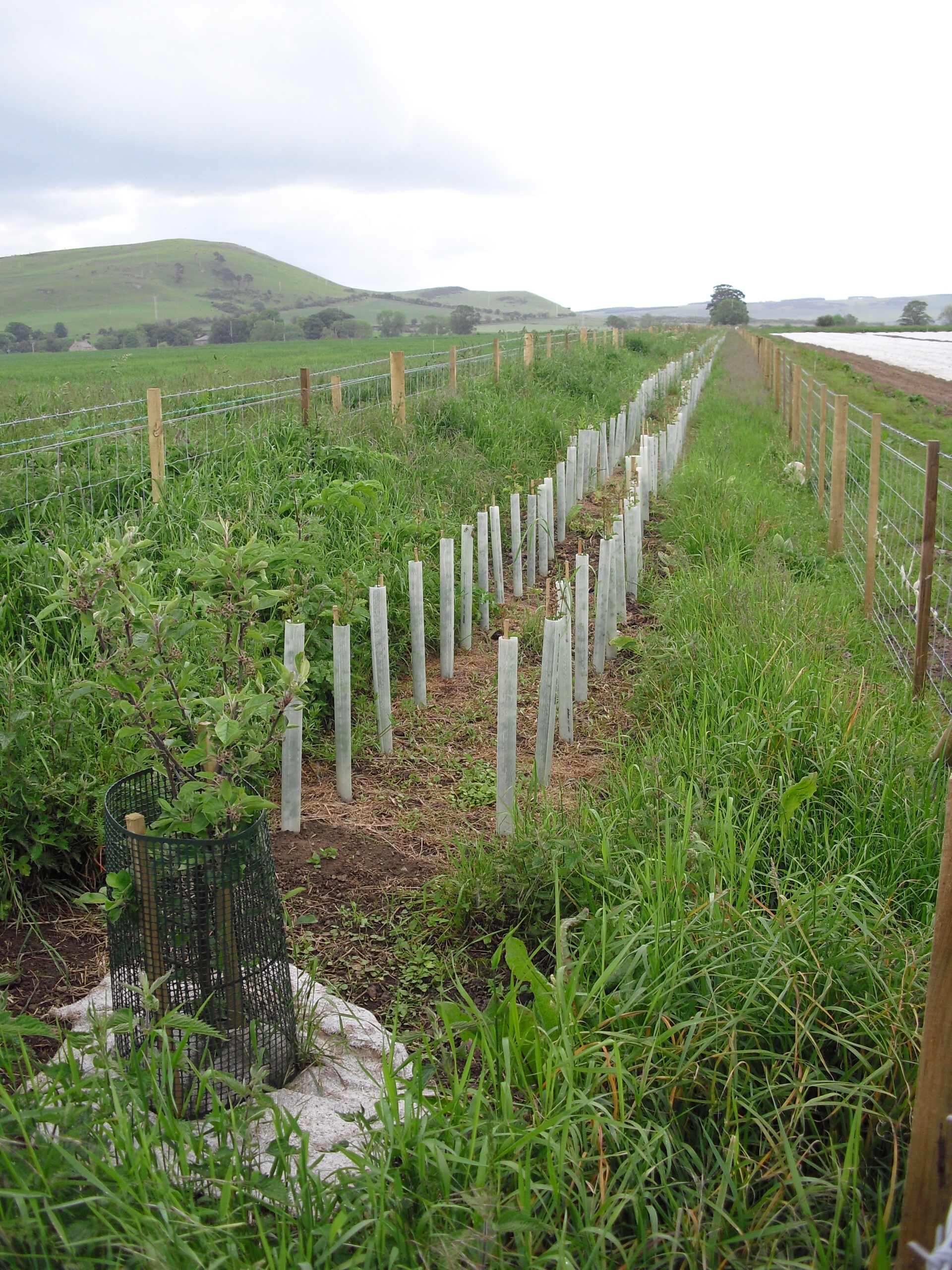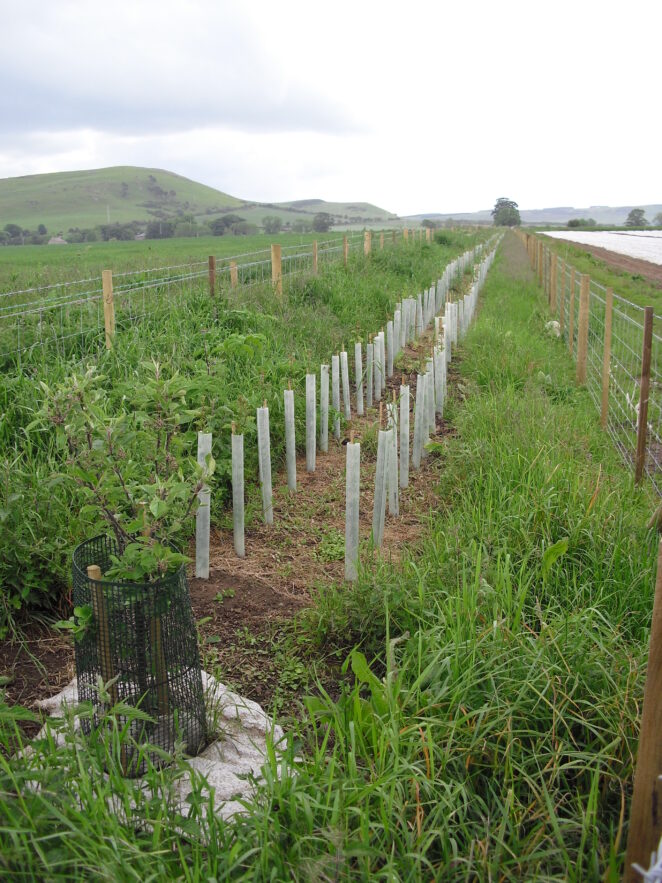Case-study /
Strategic Native Planting


Planting trees as native woodland or hedgerow features on farmland has long been recognised as being of all round benefit to conservation and biodiversity, and is actively encouraged through agri-environment schemes.
Climate Change predictions for the Cheviot Hills suggest that, as generalised trends, we should expect drier summers with increased temperatures, wetter winters, and a greater incidence of severe weather events. Such predictions present impacts and difficulties for land managers such as heat stress in livestock, moisture deficits in grazing ground, erosion of soil resources through windblow (associated with drier ground and severe weather), run-off management issues, and increased incidence of flood risk.
Land managers can adapt to such impacts through the careful placing of native tree planting projects. Woodlands and hedgerows can intercept run-off and hold back flood waters,as well as increasing the rate of infiltration from rainfall. In addition they provide a windbreak and a barrier to intercept soils mobilised by windblow, provide shade and shelter to livestock and also connect areas of valuable habitat.
Policy context
Planting of woodlands and hedgerows can be a resilience measure suitable for a large number of farm holdings. Support is currently available towards the costs of planting and maintenance through a variety of agri-environmental approaches, including Environmental Stewardship (Entry Level and Higher Level), and the English Woodland Grant Scheme (EWGS) in England, and the Scotland Rural Development Programme (SRDP) – Land Managers Options and Rural Priorities in Scotland. The new arrangements for agri-environment schemes are currently being finalised but similar support could be available in the future too.
Considerations
New planting may require authorisation from statutory bodies such as Natural England/Scottish Natural Heritage (SNH) on Sites of Special Scientific Interest (SSSI) or other protected sites. If planting in excess of 0.25ha the Forestry Commission should be contacted. By planting at least three species within a woodland or hedgerow, you can maximise the chances of the planting being successful under uncertain climatic conditions. See the UK Forestry Standard guidelines on forests and climate change for more information.
Costs of Strategic Planting Works
Every farm is different, and each will lend itself to different sites being suitable for planting in a strategic way. However, the following outline costs give an indication as to the costs involved, and an idea of rough figures:
1. Fencing Work
Hedgerows and native woodlands need good quality, stock-proof fencing to enable trees to establish. On floodplain sites, an enhanced specification of fencing is likely to be required – please refer to the Cheviot Futures floodplain specification fencing case study for more information. Hedgerows will need to be double-fenced along each side of the trees; this fencing may also include an additional guard wire to keep cattle back from the trees; woodlands may need deer fencing.
- Approximately £5.00 per m
2. Planting Costs (Costs as of 2012)
- Approximately £2,500-3,000 per ha (depending on ratio of open ground) for woodland at 1,600 stems/ha (standard EWGS/SRDP planting rates)
- Approximately £1,050 per ha for woodland at a rate of roughly 500 stems/ha as scattered clump planting
- Approximately £5-7 per linear m for hedgerow planting of a double row at approx. 6 plants per m (standard planting rate)
- Approximately £7-10 per linear m for enhanced windbreak approach planting with a range of tree ages (young whips through to standard trees)
3. Other Costs
The trees will need maintenance to ensure they establish and thrive. This will include a minimum of ‘beating up’* to replace failed stems, spot sprays to control weed burdens around the trees, and in the longer term removal of protective tubes and stakes once they have become established.
* Replacing trees that have died shortly after planting.
Case study
North Doddington, near Wooler, Northumberland (55.587768, -2.003664)
On this site we have worked closely with Catchment Sensitive Farming (CSF) and Natural England through the existing farm Higher Level Stewardship (HLS) agreement. A number of resilience issues, identified through the innovative Cheviot Futures Farm Resilience Planning (FRP) approach, have been addressed.
The main issue identified in the FRP was the loss of valuable soil resource due to windblow. By planting a hedgerow as a windbreak, an open section of farm has been broken up, reducing the velocity of wind, whilst also creating a physical barrier to capture soils that become mobilised. The hedgerow feature will offer shade to livestock in times of increased temperatures, and also shelter in extreme weather, as well as providing connectivity of habitat to assist wildlife resilience.
Work was completed during the winter planting season of 2011-12, with approximately 1.2km of hedgerow habitat reinstated, within a buffer of approximately 2.5metres. Existing mature and semi mature trees and shrubs were retained, and the length of the boundary running from one side of the farm to the other was planted with a range of native tree and shrub species. This ensured a habitat with differential layers and age structure, to maximise the feature’s effect as a windbreak.
Mowhaugh, Bowmont Valley, Scottish Borders
70m of new hedgerow has been planted in an effort to assist the stabilisation of a severely eroding high riverbank. The tree roots will hold the soil structure together at the top of the bank and increase the vegetation cover. In addition, the hedge will also play a role in intercepting surface water runoff from the surrounding sloping fields, slowing down the rate of flow and the amount of water to then fall from or run down the eroded face of the high bank.
This will reduce the erosion risk from the top of the bank. The erosion risk from the river below will need to be addressed separately as part of wider resilience efforts. As well as the hedgerow element of this site, various areas of riparian land have been planted with native trees within a separate planting project, with funding support through SRDP.
Planting native trees alongside watercourses, particularly in the upper reaches of a river, and also in small upland cleughs and gullies can greatly assist the natural management of flooding and associated flood and erosion risks. These works are of greatest benefit as a collaborative, catchment scale approach such as that being developed in the Bowmont Valley through Cheviot Futures.
High flows are slowed down and backed up in riverside planting, reducing the peak flood flow in the main watercourse, as well as trees providing a greater rate of infiltration, making more use of more water before it reaches the river system.
Acknowledgements
Funding was made available from Northumberland Uplands New LEADER Local Action Group (funded by Rural Development Programme England, which is funded through European Union and DEFRA/Scottish Government).


